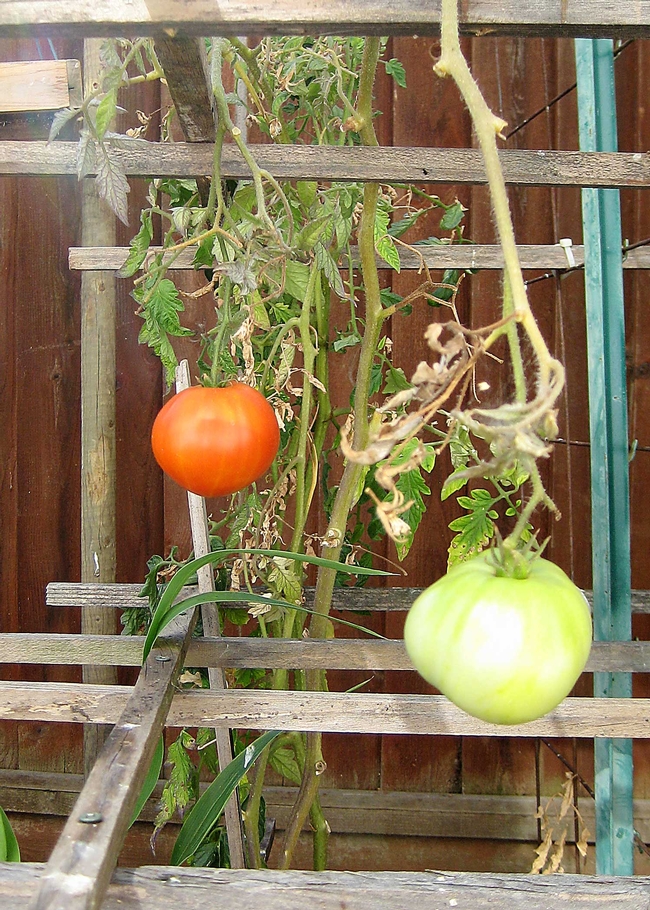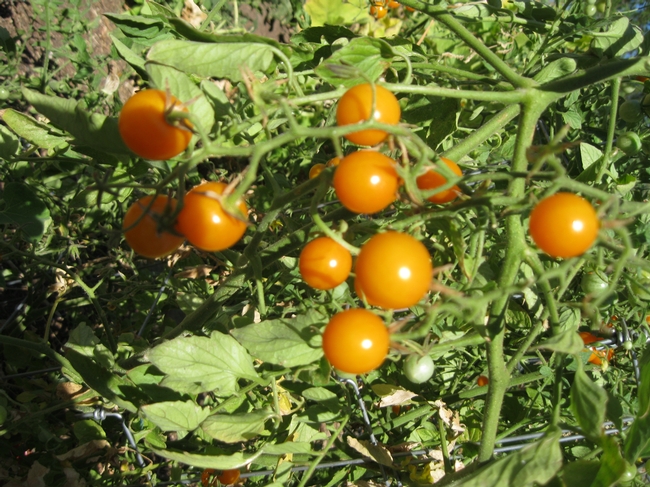- Author: Kathy Thomas-Rico
Whew. It looks as if we may have survived that eight-day 100-degree-plus “hot spell” around July Fourth. It was brutal, and there was so little — other than watering every morning — that we could do for our plants. The big boys — the trees and larger shrubs — look positively shiny and new now that the Delta breeze has returned and nights and mornings are much cooler. Alas, some of the smaller plants did not fare well. They simply and literally were baked by the heat and sun.
It looks as though we have lost a few daylilies, and they’ve been in the back yard since before we moved here in 2002. Just goes to show you how unusual that long heat wave was. Our tomatoes, peppers and squash are much worse for wear, as well, but seem to be rallying. Needless to say, we have some precooked tomatoes still on the vine, and the bell peppers already have sunburn.
I have to look on the bright side: This baking of our daylilies offers me the chance to plant something new, obviously something more heat-tolerant. Cacti need not apply. Any suggestions?

- Author: Cheryl A Potts
If you were to poll the Master Gardeners who sit at information booths and answer questions from the public regarding problems they might be having in their gardens, my bet would be that the majority of those questions deal with tomatoes. And understandably so, as 93 percent of home gardeners in the U.S. grow tomatoes. I thought, just for fun, I'd look at some other interesting facts regarding this fruit, er, I mean vegetable, I mean, er well, whatever.
The Department of Agriculture states that Americans eat between 22-24 pounds of tomatoes per year, but most of that is in the form of either ketchup or tomato sauce. In recent years, salsa has passed up ketchup. (Ketchup always has run slow.--sorry, couldn't resist) At the grocery market, the tomato is the 4th most popular vegetable, running behind potatoes, lettuce, and onions.
Americans have increased their consumption of the tomato over the past 20 years by 30 percent, mostly in the processed forms of sauces, paste, and salsa. I realize that I have no memory as a kid of eating salsa. When did that get invented? And even more important, what did we put on those chips?
Fresh market tomatoes are raised in all 50 states, the majority grown in Florida. However, California grows 96 percent of the tomatoes that are processed. Worldwide, China grows the most, the U.S. second.
The tomato is believed to have originally come from Peru, its Aztec name being "xitomati", which means "plump thing with a navel". The scientific name is Lycopersicon lycopersicum which means "wolf peach".
No one can agree on how many variety of tomatoes there are. The estimates run between 10,000 and 25,000. My guess as to why there is this discrepancy is because new varieties are constantly popping up. Isn't 25,000 enough? I already have such a hard time every spring deciding what variety to plant.
The heaviest tomato recorded weighed in at 7 lbs. 12 oz., grown by Gordon Graham of Oklahoma in 1986. After weighing, Mr. Graham sliced the tomato and made sandwiches for 21 people.
The largest known tomato plant was a 'Sungold' variety, whose height was recorded in the year 2000 as 65 feet tall. It was grown by a company in the U.K. (I have a 'Sungold', and up to this very minute, thought it was doing very well at 6 feet.)
The tomato is the official fruit and vegetable of Arkansas while the official drink of Ohio is tomato juice.
The largest tomato festival in the U.S. appears to be the one held in Arkansas which continues for a whole week and has over 30,000 visitors and tasters. However, if you really want to have fun, you may want to go to Spain on the last Wednesday in August for La Tomatina where 30,000 participants throw 150,000 tons (not pounds, but tons) of over ripe tomatoes at each other. Guess that is better than throwing over ripe watermelons.
Now to answer that age old question, is the tomato a fruit or a vegetable? Botanically, a tomato is the ovary, together with its seeds, of a flowering plant. Therefore it is a fruit or, more precisely, a berry. But by US tariff laws, a tomato is consider a vegetable. The applicable law define produce by its use and not its scientific classification. From a culinary point of view, a tomato is a vegetable.
So, Farmers Market Master Gardeners, this article may not be helpful to you in solving that one difficult tomato question, but you will have a lot to chat about while your partner at the table looks up the answer.

- Author: Trisha Rose
Best ever tomato results. I wrote about Pruden's Purple early spring. I picked this tomato start at Morningsun Herb Farm on the drive home from a Master Gardener's tour of Pleasants Valley Iris farm. The sturdy little start had a cute name with a promise of a vigorous bush. I had some old trellises that I tied together in a teepee arrangement. Pruden's promised to grow to about 6 feet tall, so I wanted to give a strong support system. My backyard is mainly lawn with a rose bed in a carved out piece with good sun exposure The tree roses surround the bed so I have the middle portion to experiment. This is where Pruden's grew to a glorious result. As the large tomatoes began to change from light green to a soft rosey orange, I kept waiting for the "purple" coloration to show. By late August I started consulting my various sources and found a lot of enthusiastic dialog for this variety. I found that 'Pruden's' is frequently compared to 'Brandywine'. Both are meaty and very flavorful. I have tried 'Brandywine' in the past with no success. But 'Pruden's' is by far my best achievement in the world of tomatoes. I found the coloring is really not purple at all but more a rosey color. Bingo! I got out my pruners and cut off my first specimen. The stem is large and strong since the fruit weighs a good pound or so, my scissors weren't up to the job. I washed off the tomato and began to slice through cutting big chunks off the main fruit. I realized as I looked at my plate the resemblance to a plate of seedless watermelon chunks The flesh was very meaty with few seeds and very thin skin. What a joy tossed with olive oil, balsamic and salt and pepper. My goodness, Pruden's has won a place in my garden for sure.

- Author: Sharon Leos
As I write this blog entry, November is four days away. At this time in a normal weather year, the summer vegetables would be done and gone. I would have removed the summer plants and tucked in the garden until next spring. We all know 2011 not been a normal weather year.
I have cleaned out the dried and broken corn stalks, the zucchini vines that shrived into spiny twine, and the tomato plants - except the one last tomato plant that still has two great tomatoes. I could not bring myself to rip it from the ground.
I know the plant looks ridiculous - especially since I pruned back most of the spent leafless branches and the rest of the bed is empty.
I know the last two tomatoes will probably not taste anything nearly as good as the sweet delicious globes we harvested in August.
I know the frost will be here faster than you can say “Under the Solano Sun” and the plant will be finished for sure.
But for some reason this year, holding on to one last bit of summer seems to be helping me ease into the short and dark days of fall and winter. I look out the kitchen window and see the bright red tomato ripening and it makes me smile. And the tomato plant is holding on to summer, too. There is cluster of new flowers opening on the other side of the plant.

I was told a compassionate gardener would let the plant go after a long season of producing tomatoes. Maybe I am being a selfish gardener by keeping the plant in the garden. Maybe I am being a compassionate gardener by allowing the plant to fulfill its productive destiny. Maybe I am an experimental gardener by growing beyond the normal season! Maybe if I get some plastic sheeting and grow lights… or, maybe not.
- Author: Susan Christiansen
That would be ‘Sungold’ tomatoes (Solanum lycopersicum) in the Solano Foothills. (What an appropriate choice for our Under the Solano Sun Master Gardener blog.) Nothing tastes better than tomatoes fresh from your garden; however, some tomatoes are better than others. ‘Sungold’ tomatoes are among the most sweet, prolific, and tolerant tomatoes available.
How sweet are they? They have been compared to liquid sun, sugar candy, and gems of golden flavor. Their big fruity flavor makes them great straight from the vine, in salads, and pasta sauces (see recipe below).
The vines get huge, so allow for lots of room and extra tall tomato cages. They are the first to mature and the last to harvest, and although small, the plants produce so many that it is hard to keep up with them.
Requiring full sun, this little orange indeterminate American hybrid is disease-resistant to Fusarum wilt, Verticillum wilt, root knot nematodes, and tobacco mosaic virus. They are so hearty that volunteers easily pop up in your garden. They flourish in the ground, in raised beds, or in containers. Even with late rains, cold, and frost like we have had the last two seasons, ‘sungolds’ keep on producing when other tomatoes get “touchy”.
‘Sungolds” won Great First to Ripon Race of 2011 and third place out of more than one hundred tomatoes at the Morningsun Herb Farm 2010 Tomato Day. Next time you are looking for a tomato to plant, seriously consider this golden nugget.
Sungold Pasta Sauce
1 cup (or more)‘Sungold’ tomatoes cut in half
sea salt and white pepper to taste
1-2 Tbs fresh minced basil
3-4 ears of white corn with kernels removed
2-3 cloves of minced garlic (varies with your taste)
2-3 Tbs. butter
2-3 Tbs. virgin olive oil
1 cp white wine
1 lb sea scallops seared in butter
1 pound fresh pasta cooked no longer than 3 minutes
Parmesan cheese shavings
Sauté garlic in butter and olive oil. Add ‘sungolds’, corn kernels, salt, pepper, basil, and wine. Cook about two minutes. Pour on top of pasta, sea scallops, and cheese. Enjoy.



